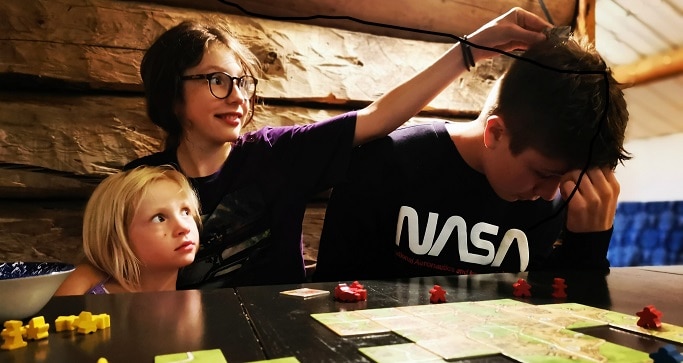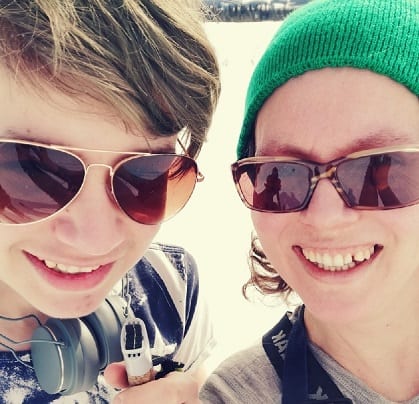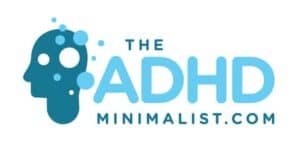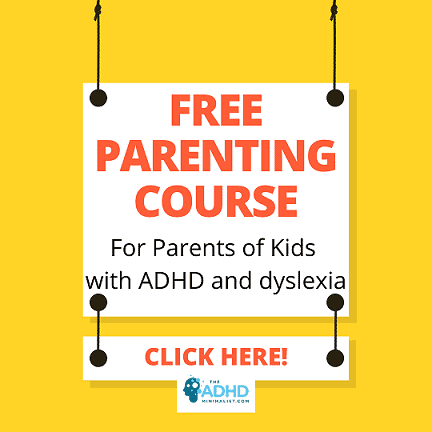My ten-year-old is proof that Minimalism reduces ADHD
My son suddenly threw out ¼ of his stuff and declared that all the extra junk in his room made him feel stressed.
I made a classic blunder and tried to convince him to keep it! Fortunately, he was determined to have a decluttered room!
He finally found the words to explain that having only the things he needed and loved in his room made him feel calmer and less prone to ADHD symptoms.

Why does a minimalist environment reduce ADHD symptoms?
Because homes inspired by minimalism are not overwhelmed with things they are naturally much cleaner and easier to organize. The minimalist aesthetic often promotes white or neutral colors, which in themselves can be calming to the ADHD mind.
For my son, the minimalist way of life was a choice of necessity. When he needed to escape the chaos of school and family life, his room became a safe haven where he could feel free from ADHD symptoms.
When my son begged me to look at life through his eyes, I realized that a clutter-free home made him feel calmer.
As I decluttered the family living spaces he was able to spend more time in positive interactions with the family. Before the declutter interactions with his siblings were mostly negative.
I had to make a major lifestyle change in order to create the optimal living environment for my ADHD kids.
My son was diagnosed with ADHD predominantly hyper and dyslexia around the age of eight.
A few years later my daughter was diagnosed with ADHD predominantly inattentive and dyslexia. Her tests showed that she will probably struggle in school even more than her older brother does.
If something as simple as giving away excess stuff, can help my kids succeed in life, why wouldn’t I try it?
How minimalism reduces ADHD symptoms for my son
It all started when my oldest, Lage, was ten. He is now thirteen.
I came downstairs one afternoon and made a beeline for the bathroom only to find that I couldn’t get there! A huge pile of stuff was blocking the hallway!
I picked my way around the mound of clothes, books, electronics, and toys and stuck my head in my son’s room. He was frantically cleaning. Every third or fourth item he picked up he tossed in the hallway.
‘’Mom, I’m getting rid of that pile because I HATE having a cluttered room!
All these things that I don’t like or use are only in here because you think they should be!
I am sick of feeling stressed because there is nowhere in this house where I can get away from the clutter!
Why do you keep putting stuff in my room that I don’t want? This mess is all your fault!!!’’ -Lage
Unfortunately, my first thought was ‘He can’t get rid of all that!’ I picked up a new sweatshirt and tried to convince him to keep it! My suggestion was met with an emphatic NO!
His response made me reevaluate the role of possessions in our home.
I finally got the point! I had to let him get rid of things, even expensive things, that I paid for. If he felt the effects of ADHD less, in a calm clutter-free environment then that’s what we needed to create in our home.
For the first time, it dawned on me that by reducing our possessions we could reduce Lage’s ADHD symptoms!
How having less is calming for the ADHD mind
It’s been proven that cluttered homes create high-stress levels.
- In a study I found on PubMed.gov they asked several women to describe their homes.
Women who used words such as cluttered and disorganized to describe where they lived had unhealthy cortisol levels. In fact, their levels were so bad that doctors looking at their results would probably draw the conclusion that these women were in very poor health.
They also noted that women who were not satisfied with the state of their home were more likely to be depressed.
On the other hand, women who described their homes as relaxing calm spaces had good cortisol levels and were less likely to be depressed.
- A second study published on PubMed.gov by Princeton University showed that visual clutter can distract you from completing tasks. Clutter in your environment can cause your Visual Cortex to be overwhelmed.
When this happens it’s hard for your brain to focus on completing the tasks that are most important for you to get done.
- A study from Indiana University found that people with cleaner houses were healthier.
They studied 998 African Americans who were all between the ages of 49-65. People who had clean homes were more physically active.
This may be due to the fact that they were walking around their home picking up and doing laundry part of the day, or that a clean home leaves space on the floor to do an at-home workout.
Those with clean uncluttered homes were generally more healthy than people who lived in messy homes.
The sources for these studies are at the end of my post.

How those with ADHD are affected by clutter
These are some of the negative side effects that clutter has on my son.
Every person with ADHD is different. Some may not experience all of these side effects when surrounded by clutter. Others may experience them in different degrees of severity.
- Clutter = extra stress.
When my son tries to do homework at our kitchen table and our kitchen is a mess he can’t concentrate.
Homework always makes him stressed. When you add a stressful cluttered environment on top of his automatic stress response to homework that = He just wants to hurry up and get the homework done!
He doesn’t care if the homework is done well, he just wants it DONE!
When he is stressed and hurried his ADHD takes over and everything takes twice as much time for him to finish!
The problem is, when he is trying to be extremely fast it makes him slow!
Often when in this state he makes so many typing mistakes that I have no idea what he was trying to write in the first place!
Instead of getting his homework done faster, he has to start over.

- Clutter = Anxiousness
Before we decluttered Lage would pace back and forth in the living room or kitchen/diner. He would only sit for a few minutes at a time before he popped back up and started pacing again.
Sometimes he would pick up a toy or book, finger it for a few minutes, then he would put it down and go back to pacing.
You could feel nervous energy emulating from him and nothing we did seemed to help him relax!

- Clutter = forgetfulness
Lage used to talk incessantly. (He still does every once in a while, but not often) I believe the clutter in the house cluttered up his mind as well.
He told me on many occasions that he was afraid of forgetting what he wanted to say, so he felt the need to say everything he was thinking of immediately!
His continuous string of words didn’t allow anyone else to get a word in edgewise, and he couldn’t understand why we weren’t able to give our undivided attention to his random, often disconnected, thoughts.
He wanted our full attention from 2:15 in the afternoon to 9:00 in the evening!
It’s extremely hard to give someone your undivided attention when you are being talked at and not actually having a conversation!

- Clutter = Clinginess
The stress of living in a cluttered environment caused Lage to zone in on my husband and I and cling to us with a desperate clinginess!
It’s as if he needed something to hold on to in the sea of moving clutter. Something that made him feel centered and secure.
The problem was that he was not allowing my husband and me to function normally.
I only worked in the mornings while the kids were at daycare and school because he refused to go to afterschool activities.
I met him and his sister when they got off the bus at 14:15, but I was not enough! He would try to monopolize my attention, so I couldn’t help the girls.
Some days things were so bad I had to call my husband to leave work and come home so one of us could be with Lage and the other could care for the girls!
You may think that we just needed to set boundaries, but Lage was in a crisis and none of the traditional methods worked. We didn’t know how to help.
We sought help from doctors, nurses, and psychiatrists without anything they suggested actually helping!
It wasn’t until we started clearing clutter that he started to relax some of these behaviors!
(We also started trying to strengthen our connection to Lage. If you want to read about that click here. How Limbic Bonding Transforms ADHD Children)
Having less stuff keeps us from going on ADHD rabbit trails!
Those with ADHD often try to do several things at the same time, usually with unsatisfactory results. Having less stuff often helps the ADHD mind concentrate on doing fewer tasks at once.
If you’re like me (An educated guess tells me that I probably have ADHD as well) you’re easily distracted when cleaning!
I start cleaning in one area of the house and I find something that belongs somewhere else. I get distracted when I leave my primary cleaning area to put it back!
Let’s say you find some books in the living room that need to get to the bedroom.
Instead of collecting all the rage items in a basket to put away later, you go to the bedroom immediately to put the books back.
While in the bedroom, you notice there are clothes on the floor which you start to pick up.
This takes you to the bathroom to leave the dirty laundry and on it goes, the whole house gets a little cleaner but you finish cleaning nothing!
I found that having less stuff in my home keeps me from going on many of these rabbit trails.
There are simply fewer things to be put away in different parts of the house which can distract me from my main cleaning goal!
Family Minimalism is attainable for all ADHD families
I am the mother of three kids, two of which have ADHD and dyslexia.
I never thought my life would include family minimalism. There has always been a lot of stuff surrounding me. We probably still have more stuff than most minimalists and that’s ok!
Minimalism should look different for everyone and every family!
I like the term ‘Family Minimalism’. I am not sure who first coined this phrase, but I associate it with Joshua Becker. He was one of the pioneers of family minimalism.
The point of Family Minimalism is to make family life easier!
Don’t confuse Family Minimalism with other extreme forms of minimalism. Family minimalism does not mean that you live in a white box with only 100 items!
Family minimalism should be unique to every family and include things like simplifying toys and clothes so it’s easier to pick up the house.
Fewer items of clothing mean that laundry takes less time!!!
In other words, Family Minimalism is about reducing what we own to free up the time we routinely invest in THINGS!
With the extra time and mental clarity we get from having less stuff to organize, clean, wash, sort, and store, we can lavish on the most important people in our lives, our families and close friends!
I could never live in a house stripped down to the bare essentials and devoid of everything that makes a house a home.
In Sweden, we have the word ‘Lagom’ which essentially means To have the perfect amount.
For most of us, the perfect amount of possessions was surpassed a long time ago.
If you find inspiration to start minimizing from my article, send me an email and let me know! You’ll find my email address on the home page menu under contact me. I’d love to hear from you.
To read more about ADHD and Minimalism check out some of my favorite blog posts below!
How to let go of things, and deal with fears This post is about how I got over my fear of getting rid of my stuff!
Don’t make the same 10 minimizing mistakes I did! I made some dumb mistakes!
Decluttering kids toys and other monsters in their rooms. A cleaner room helps my kids feel calmer.
How to cope with a child’s diagnosis, Minimalism can help This post is about how I learned to cope when 2 of my kids needed diagnoses.

How it feels to have ADHD in a thirteen-year-old’s own words Ever wonder what goes on in an ADHD teenagers brain?
15 reasons why Kids with ADHD and Dyslexia should play games How games help kids with ADHD and Dyslexia develop life skills!
A Monochrome bedroom decreased my daughters stress and ADHD Having less stuff even helped my packrat daughter!
For more information and book tips check out the page Our Favourite Resources. Click here Our Favourite Resources.

(Source) https://pubmed.ncbi.nlm.nih.gov/19934011/
(Source) https://pubmed.ncbi.nlm.nih.gov/21228167/
(Source) https://newsinfo.iu.edu/web/page/normal/14627.html
Copyright Annie Eklöv

